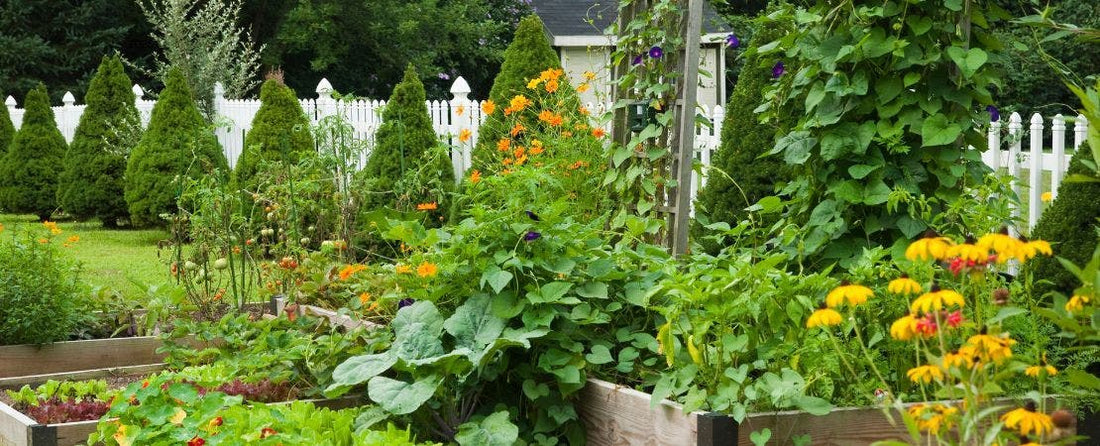
Top 12 Gardening Trends for 2025
Share
Explore the Top Gardening Trends for 2025 That Are Transforming How We Grow
As we approach 2025, gardening continues to evolve, reflecting broader societal shifts towards sustainability, technology integration, and personal well-being. Emerging trends highlight a collective move towards eco-friendly practices, efficient resource use, and the creation of personalized green spaces. Let’s dig into the key gardening trends anticipated for 2025, and explore their significance and practical applications for gardeners.
1. Edible Landscaping and No-Dig Gardening
The resurgence of homegrown produce is a prominent trend, with gardeners increasingly integrating edible plants into their landscapes. This approach, known as edible landscaping. The no-dig method complements this trend by enhancing soil health and reducing labor. By layering organic matter on the soil surface, gardeners add to soil health with minimal soil disturbance. This technique boosts productivity and aligns with sustainable gardening practices.
2. Wildlife-Friendly Gardens
Creating habitats that support local wildlife is gaining traction among gardeners. By planting native species and allowing certain areas to remain undisturbed, pollinators like bees and butterflies, as well as other beneficial creatures. This approach fosters biodiversity, aids in pest control, and contributes to the ecological balance. Embracing a less manicured aesthetic, such as leaving seed heads and fallen leaves, provides food and shelter for wildlife during colder months.
7. Integration of Artificial Intelligence in Gardening
The advent of artificial intelligence (AI) is revolutionizing gardening practices. Design applications utilize AI to provide personalized garden layouts based on user preferences and site conditions. Reminder apps assist in scheduling watering, fertilizing, and other maintenance activities, ensuring optimal plant health. These technologies enhance efficiency and accessibility, making gardening more approachable and time-constrained individuals.
9. Embracing Minimalist and Sustainable Garden Designs
Minimalist garden designs featuring clean lines and sustainable materials are on the rise. Utilizing elements like gravel, concrete, and metal creates sleek, low-maintenance landscapes. Incorporating native plants and reducing lawn areas contribute to sustainability by lowering water usage and providing habitats for local wildlife. This design approach aligns with a broader eco-friendly living and resource conservation.
10. Focus on Mental Well-Being and Outdoor Living Spaces
Gardens are increasingly recognized for their role in promoting mental health and well-being. Creating tranquil outdoor spaces for relaxation, meditation, and recreation is a growing trend. Features like comfortable seating areas, vertical growing for privacy, water elements, and diverse plantings contribute to a restorative environment. Gardening activities themselves have therapeutic benefits, reducing stress and enhancing mood.
11.Container Gardening: Growing Versatility in Small Spaces
Container gardening for gardeners with limited space. Flowers like compact sunflowers, petunias, and pollinator-friendly zinnias are popular choices for adding vibrant color to patios and balconies. For vegetables, container favorites include cherry tomatoes, peppers, and leafy greens like kale and spinach, which grow well in small spaces.
To maximize container gardening, use high-quality potting soil, pots with good drainage, and vertical supports for climbing plants. This approach ensures healthy plants and efficient use of space, making container gardening an ideal solution for urban and small-space gardeners.
12.Climate-Resilient Gardening
Gardeners are increasingly adapting their practices to unpredictable weather, choosing hardy plants, resilient seeds, and flexible designs to ensure success despite shifting climates. The popularity of container gardening supports this practice as plants can be moved to offer protection from destructive weather events.
The gardening trends anticipated for 2025 reflect a blend of tradition and innovation, emphasizing sustainability, technological integration, and personal well-being. Gardeners are adopting practices that support environmental health, resource efficiency, and biodiversity. Embrace these trends to create resilient, productive, and beautiful gardens that contribute positively to our lives and the planet.



